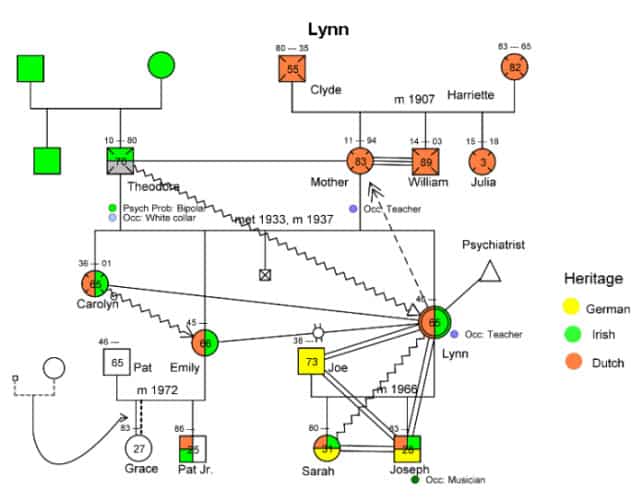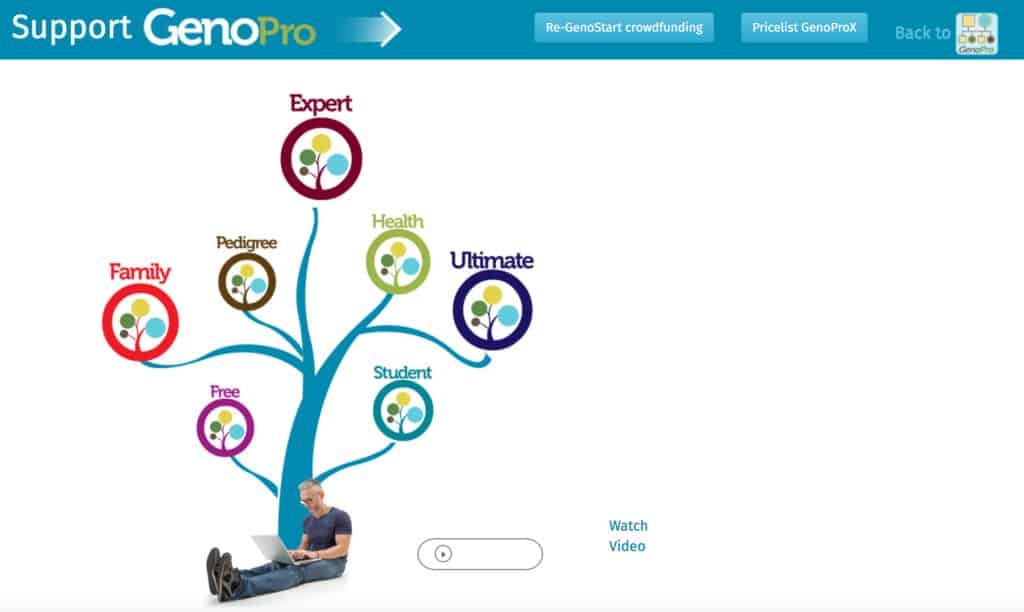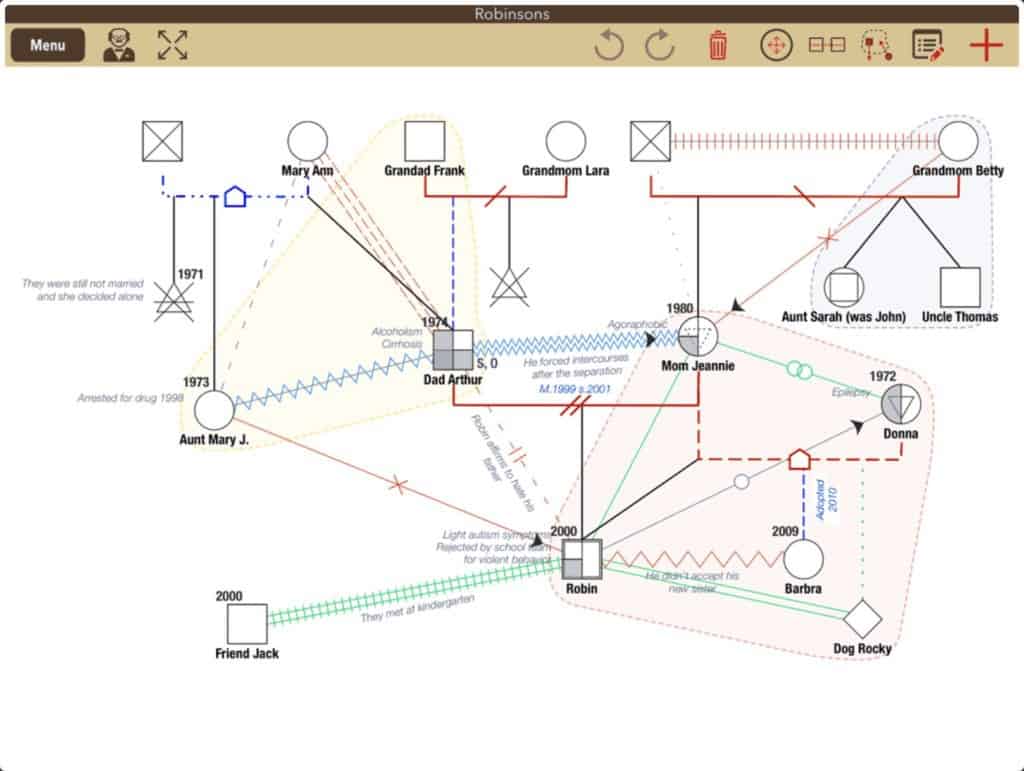If you need to draw medical or psychological conclusions from a family’s history, you’ll want the right genogram maker for Mac.
In this guide, I’ve rounded up the best genogram tools that work well on macOS – whether you’re a student, therapist, counselor, or medical professional.
Many Windows users still turn to GenoPro, but it’s never had an official Mac version. Thankfully, there are now lots of powerful alternatives, including newer Mac-native options and more cloud-based tools that fill the gap perfectly.
Table of Contents
- Genogram Makers: What You Need To Know
- 1. Genogram Analytics
- 2. Progeny Pedigree
- 3. GenoProX
- 4. EdrawMax
- Extra Tip: iGenoGram (for iPad & iPhone)
- Other Alternatives
- Why Use Genogram Software Instead of Pen & Paper?
- Which Professions Use Genogram Tools?
- Genogram vs Family Tree: What’s The Difference?
- Conclusion
Genogram Makers: What You Need To Know
Creating a proper genogram is more specialized than just using family tree software to trace your family history.
You’ll need tools with specific relationship symbols, medical condition markers, and clear ways to map complex family dynamics like adoption, foster care, estrangement, or hereditary conditions.
Generic genealogy apps often don’t cut it. The same goes for templates in PowerPoint or Word – they may look like “family trees,” but they won’t give you the professional-level features that a real genogram diagram needs.
Here then is what’s working best for Mac users in 2025.
1. Genogram Analytics

Genogram Analytics continues to lead the pack in 2025. It balances ease of use with deep, professional-level features making it popular with students, LCSWs, and licensed therapists alike.
New for 2025, the developers have added cloud collaboration, so you can securely share genograms with colleagues or clients online. It’s also been updated with new templates for diverse family structures, including better support for multi-parent households, same-sex couples, surrogacy, and culturally specific relationship markers.
Key Features of Genogram Analytics are:
✅ Highly customizable – track relationships, emotional ties, medical conditions, and more.
✅ Handles adoption, incarceration, foster care, substance abuse history.
✅ Works offline – Mac and Windows desktop apps.
✅ Optional cloud storage & sharing.
Pricing: $195 license (discounted student pricing available)
2. Progeny Pedigree

Progeny Pedigree remains one of the most trusted pedigree chart tools for genetic counseling and hereditary risk assessment. While it’s more of a pedigree tool than a traditional genogram maker, it’s widely used by hospitals and research institutions.
For 2025, Progeny’s cloud platform has new HIPAA-compliant sharing and easier integration with EHR (Electronic Health Records) systems, making it more practical for medical teams collaborating remotely.
Key Features of Progeny Pedigree are:
✅ Draw unlimited pedigree charts, track up to 10 genetic conditions.
✅ Fit charts to page for clean printing.
✅ Premium cloud version supports advanced genetic risk modeling.
Pricing: Free trial, Premium Cloud starts at ~$2,500/year.
3. GenoProX

Good news for longtime GenoPro fans: GenoProX, the cross-platform successor to the original GenoPro, is now stable and Mac-compatible. GenoProX is still mainly used by large clinics, but the GenoProX Family version is ideal for independent therapists or even hobbyists who want a powerful kinship diagram tool.
In 2025, GenoProX also includes GenoShare, which lets multiple family members collaborate on a kinship chart online.
✅ Full cross-platform app for Mac and PC.
✅ Templates and smart automation for repetitive structures.
✅ Cloud sharing via GenoShare.
Pricing: Free plan for basic use, paid plans from $2/month.
4. EdrawMax

EdrawMax remains a solid choice if you like an Office-style interface and want a more general-purpose diagram tool with genogram support. It’s updated yearly with new symbols and templates.
New for 2025, EdrawMax now has AI-powered diagram suggestions – handy for speeding up repetitive connections when building complex genograms.
✅ Familiar ribbon layout if you know Microsoft Office.
✅ Export to PDF, PNG, SVG, and Office formats.
✅ Wide range of family symbols for genograms and ecomaps.
You can read our Edraw review for more.
Pricing: $99/year or $198 for lifetime license.
Extra Tip: iGenoGram (for iPad & iPhone)

iGenoGram still doesn’t have a native Mac version yet but in 2025, the developer says a macOS desktop client is in beta. For now, it remains a great option on iPhone or iPad, especially for counselors who want a simple but polished genogram builder on the go.
✅ Easy touch controls, slick modern design.
✅ Ideal for quick visual sessions with clients.
Other Alternatives
MacFamilyTree – This remains primarily a genealogy app for building traditional family trees, but it does offer limited kinship chart tools if you need basic relationship mapping.
WinGeno – A free option that runs on Mac with Mono. It’s very basic, has no official Mac support, and setup can be a headache, so it’s not recommended for serious work.
Why Use Genogram Software Instead of Pen & Paper?
Professionals often rely on genograms to help clients visualize family dynamics that are hard to discuss. Clear symbols and neat layouts make difficult conversations easier and digital genograms are far easier to edit, update, and securely share than paper sketches.
Which Professions Use Genogram Tools?
✅ Licensed Clinical Social Workers (LCSW)
✅ Marriage & Family Therapists (MFT)
✅ Psychologists, Counselors, and Psychiatrists
✅ Genetic counselors and medical researchers
✅ AP Psychology & CBT students
✅ Writers and novelists mapping complex family plots
Genogram vs Family Tree: What’s The Difference?
A genogram isn’t just a family tree – it’s a professional diagram that shows emotional bonds, hereditary patterns, psychological factors, and medical history.
It’s a core tool for anyone who needs to see how family structures affect behavior and health across generations.
Family Trees are designed to examine the history and lineage of families. For more, check out our guide to the best family tree software for Mac.
Conclusion
If you need to draw professional-level genograms on a Mac in 2025, Genogram Analytics is still the top pick for its power, detail, and ease of use. For clinical pedigree charts and genetic risk work, Progeny Pedigree or GenoProX are excellent choices.
If you’d like a general diagram tool that works for basic genograms too, EdrawMax remains a solid option. And if you’re an iPad user, iGenoGram is worth a look, especially with its Mac app on the horizon.
Got questions? Drop them in the comments below – we love to help you find the right diagramming tool for your practice or studies!


